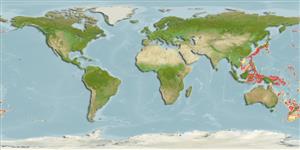>
Gadiformes (Cods) >
Macrouridae (Grenadiers or rattails)
Etymology: Ventrifossa: Latin, venter, ventris = belly + Latin, fosa = pit (Ref. 45335).
Environment: milieu / climate zone / depth range / distribution range
Écologie
marin benthopélagique; profondeur 397 - 1211 m (Ref. 95664). Deep-water
Northwest Pacific: Japan, Taiwan and the Philippines.
Taille / Poids / Âge
Maturity: Lm ? range ? - ? cm
Max length : 31.0 cm TL mâle / non sexé; (Ref. 95664)
Mouth inferior, lower jaw tipped with a long barbel, relatively small body scales, and spineless scales behind 1st dorsal fin. Head comparatively small; snout short and broad, angulated along anterolateral edge; tip of snout without spinulous tubercle. Teeth conical, with band on both jaws. Second dorsal spine finely serrated except for basal portion. Spinules on body scales slender, not triangular in shape, arranged in quincunx order. Luminous organ small, between pelvic bases. Sides of head and body bright silvery. First dorsal fin blackish, with white base and tip (Ref. 54421).
Minimum depth from Ref. 58018.
Life cycle and mating behavior
Maturité | Reproduction | Frai | Œufs | Fécondité | Larves
Cohen, D.M., T. Inada, T. Iwamoto and N. Scialabba, 1990. FAO species catalogue. Vol. 10. Gadiform fishes of the world (Order Gadiformes). An annotated and illustrated catalogue of cods, hakes, grenadiers and other gadiform fishes known to date. FAO Fish. Synop. 125(10). Rome: FAO. 442 p. (Ref. 1371)
Statut dans la liste rouge de l'IUCN (Ref. 130435: Version 2024-2)
Menace pour l'homme
Harmless
Utilisations par l'homme
Outils
Articles particuliers
Télécharger en XML
Sources Internet
Estimates based on models
Preferred temperature (Ref.
123201): 5.5 - 9.8, mean 7.1 °C (based on 375 cells).
Phylogenetic diversity index (Ref.
82804): PD
50 = 0.5000 [Uniqueness, from 0.5 = low to 2.0 = high].
Bayesian length-weight: a=0.00214 (0.00109 - 0.00421), b=3.20 (3.03 - 3.37), in cm total length, based on LWR estimates for this (Sub)family-body shape (Ref.
93245).
Niveau trophique (Ref.
69278): 3.7 ±0.5 se; based on size and trophs of closest relatives
Résilience (Ref.
120179): Milieu, temps minimum de doublement de population : 1,4 à 4,4 années (Preliminary K or Fecundity.).
Fishing Vulnerability (Ref.
59153): Low vulnerability (21 of 100).
